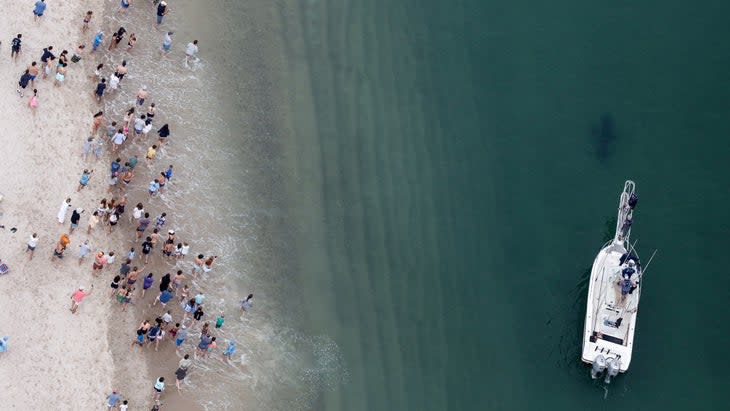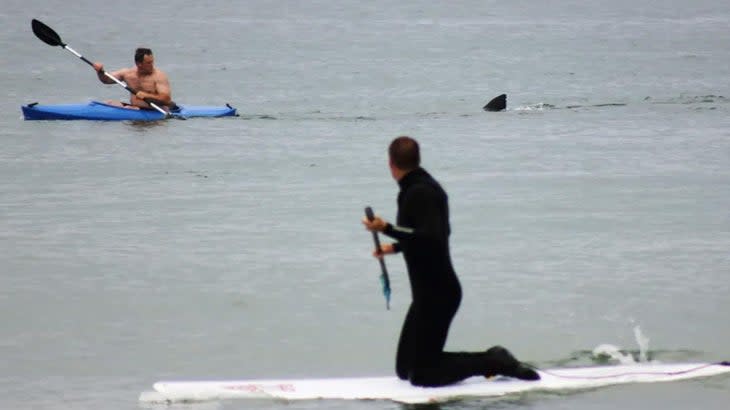Scientists Believe Cape Cod’s White Shark Population Is Big. Really Big.
This article originally appeared on Outside
Greg Skomal's phone rang in late September of 2004. The caller said that a large shark, possibly a white shark, had been marooned in a tidal salt pond on Naushon Island, just southwest of Woods Hole, Massachusetts. Skomal, a shark expert for the Massachusetts Department of Marine Fisheries (DMF), was skeptical that it was indeed one of the feared predators, which were rarely seen in the area, but he still needed to check it out. Before leaving home, Skomal decided to bring his satellite tagging equipment, just in case. When he arrived at the pond, there was no doubt; it was a female white shark about 13 feet long, weighing approximately 1,700 pounds. Over the next two weeks, Skomal and others attempted to free the shark from the tidal pond, and their efforts generated a glut of media attention.
Skomal was relieved when the shark, which he nicknamed Gretel, finally swam into open water. Before Gretel departed, Skomal affixed a tracking tag, making him the first person ever to tag a white shark in the Atlantic Ocean using satellite technology. But his elation was short-lived. "After we released the shark, the tag detached," he says. "I thought this was a career-defining opportunity, and I'd messed it up." It seemed highly unlikely he'd ever get another opportunity like that.
Nineteen years later, Skomal laughs about the ordeal. To date, he's now tagged more than 300 white sharks in the shallow waters off Cape Cod, which in recent years has seen these apex predators appear in increasingly large numbers. In a new study of the white sharks of Cape Cod, Megan Winton, a staff scientist with the non-profit research group Atlantic White Shark Conservancy, and Skomal estimate that 800 white sharks visited the shallow waters along the Cape’s eastern shoreline between June and October, from 2015 to 2018. This eye-popping number makes Cape Cod's eastern shoreline arguably the largest seasonal meeting point on the planet for white sharks.
The migratory nature of white sharks makes apples-to-apples comparisons tricky, but a 2013 study of sharks off South Africa--a well-known destination for the animals--pegged the estimated population at 908 individuals, but that study implied a much larger geographic range than the Cape Cod study. A 2021 study of sharks off the California coast estimated there to be 300 white sharks swimming off the state's central coast, a region stretching from Bodega Bay in the north to Monterey Bay in the south, and including the Farallon Islands.

The Return of New England’s White Shark Population
White sharks likely swam off the coast of Cape Cod hundreds of years ago. The current growth of the region's white shark population traces its roots in the Marine Mammal Protection Act of 1972, which prohibited the killing of seals and other mammals along the coastline. Prior to that, gray seals had been hunted nearly to extinction in New England waters. When the seal population dropped, sharks likely sought food elsewhere. But the seals maintained a remnant population in Canadian waters, and by the 1990s were expanding their numbers and range southward, establishing several pupping colonies around the Cape and Islands.
These fat-rich pinnipeds are a favorite quarry of white sharks, and the mammals' return meant the sharks weren't far behind. By the late 2000s, credible reports of white sharks near Cape Cod were on the uptick. As Skomal tells it, "We were getting more reports each summer of dead seals on the beach with wounds that could only be attributed to white sharks. In 2009, I got a call from a spotter pilot who saw white sharks off the Outer Cape," he said.
What researchers find noteworthy about the Cape Cod population is how quickly it has grown. Dr. Chris Lowe, director of the Shark Lab at California State University, Long Beach, who did not participate in this study, told me that many marine scientists were initially quite conservative about the Cape Cod shark count. "What I find most amazing is the speed at which the population recovered," he said. "Man, were we wrong."
Living in Balance with a Marine Predator
Marine scientists weren't the only ones surprised--recreational fishers, beachgoers, and water sports enthusiasts have all had to rethink their relationships with the water due to the uptick in sharks. John Murphy, a local surfer and former lifeguard, grew up on the Cape and has surfed there since the early 90s. "I could have imagined aliens coming down from Outer Space more than I could have imagined pulling someone out of the water from a shark attack," he told me. It just wasn't something people worried about. But that all changed. It went from "the last thing you think about to the first thing you think about when you put on your wetsuit."
Ground zero for reported shark activity was the Cape Cod National Seashore (CCNS), which spans 45 miles of coastline and hosts over a million beachgoers each year. The first reported incidence of a white shark biting a human on Cape Cod occurred in 2012 on Ballston Beach near the town of Truro, where a 50-year-old man was bitten while swimming 400 to 500 feet offshore; he survived, but his injuries required 47 stitches. In September of 2018, 61-year-old neurologist William Lytton narrowly survived a shark bite on his leg while swimming in ten feet of water near the town of Truro. Two weeks later, 26-year-old Arthur Medici was fatally bitten by a shark while boogie boarding at Newcomb Hollow Beach. It was the first shark-related fatality on Cape Cod since 1936.
Concerns over safety led to the creation of the Regional Shark Working Group led by Leslie Reynolds, Chief Ranger in 2012 and now Deputy Superintendent of CCNS. The group included the Division of Marine Fisheries, the Atlantic White Shark Conservancy, harbormasters, and local town officials. The group also sought the advice of shark experts from California, Australia, and South Africa, where large white shark populations have existed for decades.
Plans were quickly implemented to train lifeguards and beach safety personnel, install bleed kits and call boxes on the beaches, adopt beach signage and a shark flag warning system, and conduct ongoing public outreach and education. In 2016, the Atlantic White Shark Conservancy launched the Sharktivity iPhone app, which updates confirmed shark sightings, now for over 750,000 users.
The need for greater public safety also triggered a demand for a better scientific understanding of the sharks. Skomal told me, "The question on everyone's minds was 'how many sharks are out there?' And we couldn't answer that question." That question provided the impetus for the population study. Skomal was already tagging white sharks but had no sustainable source of funding. The Atlantic White Shark Conservancy, a non-profit organization, was established in 2012 to solve that problem. Its mission is to "support scientific research, improve public safety, and educate the community to inspire white shark conservation."

As the shark population grew, so did the desire among charter boat captains to offer shark tours. But what kind of impact would these tours have on public safety if sharks were being attracted to boats near public beaches? That question led the working group to lobby state officials to prohibit that type of interference with the sharks. It took two years, but in 2015 the DMF issued an emergency regulation prohibiting "attracting or capturing white sharks, chumming, and towing of decoys" within three miles of shore.
Today, there is a growing shark viewing business on Cape Cod. Private charters are offered by about ten operators, including AWSC. Cynthia Wigren, CEO of AWSC, told me, "Rather than using attractants to draw sharks close to boats, these tours use spotter planes to guide boats to the sharks, offering people an opportunity to see the sharks in a natural setting."
There have been no biting incidents reported on the Cape since 2018. Shark experts are correct to point out that the risk of a shark encounter is very low, especially when precautions are taken. But as Tony Pike, Beach Safety Director for the Town of Orleans, put it, "The longer we don't have an issue, the more likely we will have one. It's just a matter of time."

Professor Jennifer Jackman of Salem State University surveyed over 1,200 residents and visitors to learn about the public's reaction to the sharks. In a study published in 2022, she reported that 70 percent of Cape residents and 65 percent of tourists "feel they have control in preventing an encounter with a white shark" and 86 percent and 94 percent respectively "are willing to accept some inconvenience and risk in order to have oceans where marine wildlife can thrive."
For people like John Murphy things haven't changed that much. He's made a few adjustments to when and where he surfs, but he's still out there, even after three close encounters. The scariest one was on a cloudy day in November. "The shark came up like a submarine right in front of me, facing towards me. I turned my board toward the beach and put my shoulder down preparing to get hit when the shark turned away at the last second. I took some time off after that."
When I asked him if he ever thinks about giving up surfing, the answer was no. "It's part of my identity," he said.
The white sharks are now a part of Cape Cod's identity, too. Every bit as much as its beaches and lobster rolls. Thankfully, a diverse set of stakeholders--marine scientists, National Park officials, conservation organizations, local communities--came together to embrace and protect a once-in-a-lifetime natural phenomenon.
For exclusive access to all of our fitness, gear, adventure, and travel stories, plus discounts on trips, events, and gear, sign up for Outside+ today.

